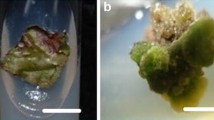Abstract
Treatment with an autoclaved culture homogenate of the yeastRhodotorula rubra induces rapid accumulation of acridone epoxides, furoquinolines and furanocoumarins in cell cultures ofRuta graveolens (L). The increased accumulation is preceeded by an induction of enzymes of the biosynthetic pathways. In the case of furanocoumarins induction was shown for phenylalanine ammonia-lyase (PAL), 4-coumarate: CoA ligase (4-CL) and S-adenosyl-l-methionine: xanthotoxol O-methyltransferase (XOMT). For PAL and 4-CL time courses of induced activity showed an early maximum, 8–12 h after treatment, whereas XOMT was found to reach its maximum later, about 36–42 h after treatment. The elicitor dose-response curve showed saturation at an elicitor concentration of 1%. At any time during the whole culturing period cells responded to elicitiation but the maximum enzyme activities induced were lower at the late stages. Experiments with different suspension culture strains, a shoot teratoma culture and hydroponically grown sterile photomixotrophic plants were performed to assess the influence of differentiation on constitutive activities of these enzymes and their inducibility by elicitation. Constitutive furanocoumarin accumulation was positively correlated with the level of differentiation. Although induction of PAL, 4-CL and XOMT activity always accompanied induced furanocoumarin accumulation no absolute correlation existed between induced enzyme activities and the induced product level or relative product increase.
Similar content being viewed by others
Abbreviations
- 4-CL:
-
4-coumarate:CoA ligase
- COMT:
-
S-adenosyl-l-methionine:caffeic acid 3-O-methyltransferase
- PAL:
-
phenylalanine:ammonia-lyase
- XOMT:
-
S-adenosyl-l-methionine:xanthotoxol O-methyltransferase
References
Bohlmann J, DeLuca V, Eilert U & Martin W (1995) Purification and cDNA cloning of anthra-nilate synthase fromRuta graveolens: Expression and praperties ofin vivo and combinant enzymes. The Plant Journal (in press)
Bohlmann J & Eilert U (1994) Elicitor induced secondary metabolism inRuta graveolens L.: Role of chorismate utilizing enzymes. Plant Cell Tiss. Organ Cult. 38: 189–194
Bradford MM (1976) A rapid and sensitive method for the quantification of microgram quantitites of protein using the principle of protein-dye binding. Anal. Biochem. 72: 248–254
Ebel J, Schaller-Hekeler, Knobloch KH, Wellmann E, Grisebach H & Hahlbrock K (1974) Coordinated changes in enzyme activities of phenylpropanoid metabolism during the growth of soybean cell suspension cultures. Biochim. Biophys. Act. 362: 417–424
Eilert U (1987) Elicitation: Methodology and aspects of application. In: Vasil IK & Constabel F (Eds) Cell Culture and Somatic Cell Genetics of Plants, Vol 4, Cell Culture in Phytochemistry (pp 153–196). Academic Press Inc. Harcourt Brace Jovanovich Publishers, San Diego
Eilert U (1989) Elicitor induction of secondary metabolism in dedifferentiated and differentiatedin vitro systems ofRuta graveolens. In: Kurz WGW (Ed) Primary and Secondary Metabolism of Plant Cell Cultures II (pp 219–228). Springer-Verlag, Berlin
Eilert U, Ehmke A & Wolters B (1984) Elicitor-induced accumulation of acridone alkaloid epoxides inRuta graveolens L. Planta Med. 6: 459–532
Eilert U & Wolters B (1989) Elicitor induction of S-adenosyl-l-methionine: anthranilic acid N-methyltransferase activity in cell suspension and organ cultures ofRuta graveolens L. Plant Cell Tiss. Organ Cult. 18: 1–18
Frohne D & Jensen U (1992) Systematik des Pflanzenreichs. (pp 177–183). Gustav Fischer Verlag, Stuttgart
Gamborg OL, Miller RA & Ojima K (1968) Nutrient requirements of suspension cultures of soybean root cells. Exp. Cell Res. 50: 151–158
Gleitz H, Schnitzler JP, Steimle D & Seitz HU (1991) Metabolic changes in carrot cells in response to simultaneous treatment with ultraviolet light and a fungal elicitor. Planta 184: 362–367
Hahlbrock K, Scheel D (1989) Physiology and molecular biology of phenylpropanoid metabolism. Annu. Rev. Plant Physiol. Plant Mol. Biol. 40: 347–369
Knobloch KH & Hahlbrock K (1975) Isoenzymes of β-coumarate:CoA ligase from cell suspension cultures ofGlycine max. Eur. J. Biochem. 52: 311–320
Kuzina EN, Kuzovkina IN, Svidchenko AI & Kunakh V A (1986) Physiological characterstic of phytohormone-autotrophicRuta graveolens callus tissue. Fiziol. Rast. (Moscow) 33: 551–557
Lois R, Dietrich A, Hahlbrock K & Schulz W (1989) A phenylalanine ammonia-lyase gene from parsley: structure, regulation and identification of elicitor and light responsive cis-acting elements. EMBO 8: 1641–1648
Marinelli F, Bonchi NV, Pini D & Salvadori P (1990) Induction of 6-methoxymellein and 6-hydroxymellein production in carrot cells. Phytochemistry 29, 849–851
Matern U (1991) Coumarins and other phenylpropanoid compounds in the defense response of plant cells. Planta Med. 57: S 15-S 20
Murashige T & Skoog F (1962) A revised medium for rapid growth and bioassays with tobacco tissue cultures. Physiol. Plant. 15: 493–497
Scheel D, Hauffe DK, Jahnen W & Hahlbrock K (1986) Stimulation of phytoalexin formation in fungus-infected plants and elicitor-treated cell cultures of parsley. In: Lugtenberg B (Ed) Recognition in Microbe-Plant symbiotic and Pathogenic interactions. NATO ASI Series, Vol H 4 (pp 325–331). Springer-Verlag, Berlin Heidelberg
Schmelzer C, Krüger-Lebus S & Hahlbrock K (1989) Temporal and spatial patterns of gene expression around sites of attempted fungal infection in parsley leaves. Plant Cell 1: 993–1001
Sharma SK & Brown SA (1979) Affinity chromatography ofRuta graveolens L. O-methyltransferase: Studies demonstrating the potential of teh technque in the mechanistic investigation of OMT. Can. J. Biochem 57: 987–995
Tietjen KG & Matern U (1983) Differential responses of cultured parsley cells to elicitors from two non-pathogenic strains of fungi. 2. Effects on enzyme activities. Eur. J. Biochem. 131: 409–413
Zucker M (1965) Induction of phenylalanine deaminase by light and its relation to chlorogenic acid synthesis in potato tuber tissues. Plant Physiol. 40: 779–784
Author information
Authors and Affiliations
Rights and permissions
About this article
Cite this article
Bohlmann, J., Gibraltarskaya, E. & Eilert, U. Elicitor induction of furanocoumarin biosynthetic pathway in cell cultures ofRuta graveolens . Plant Cell Tiss Organ Cult 43, 155–161 (1995). https://doi.org/10.1007/BF00052171
Issue Date:
DOI: https://doi.org/10.1007/BF00052171




